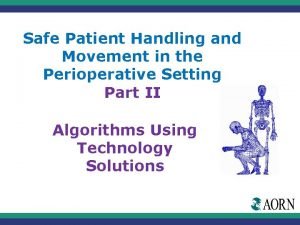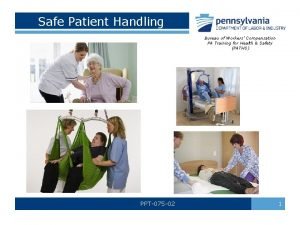Safe Patient Handling No Lift Policy Reducing The

- Slides: 1

Safe Patient Handling & No Lift Policy: Reducing The Incidence Of Work-Related Injuries Among Nursing Staff Marissa N. Scanlon, MSN, RN, PHN, CNL University of San Francisco, School of Nursing and Health Professions Methods • • Patient handling is a major risk factor for work-related injuries among health care workers Inadequate and inappropriate safe patient handling practices contribute to increased work-related injuries, lost/restricted work days, and hospital costs An estimated 12% of nurses leave the profession annually because of back injuries, 38% of nurses who suffer from back pain are placed on workers compensation, and more than 52% of nurses complain of chronic back pain and injuries (Hunter, et al. , 2010) Costs associated with work-related injuries in the health care industry are estimated to be $20 billion annually (OSHA, 2013) The Nurse and Health Care Worker Protection Act of 2013 was introduced to decrease the potential for injury to health care personnel and patients, while reducing work-related health care costs and improving safety of patient care delivery (H. R. – 2480 -113 th Congress, 2013 -2014) On a hospital wide level, the most recent quarterly FY 2014 SPH Injury Report (Jan-Oct) indicated: 47 injuries, 991 lost work days, 1, 531 restricted work days, and an estimated $1. 1 million ultimate hospital losses related to patient handling injuries Strongly Agree 80% 30% Materials on 10 9 Q ue sti on 8 Q ue on 7 sti Q ue sti on 6 Q ue on 5 sti ue Q Q ue on on 3 sti on sti ue Q 4 Strongly Disagree 1 10 on 9 sti ue Q ue sti on Q sti Q ue ue on 8 7 on sti on Q ue sti on Q sti ue 6 0% 5 0% 4 10% 3 10% 2 20% 1 20% on 30% Disagree 40% Q ue Strongly Disagree sti 40% 50% 2 Disagree Neither on 50% 60% ue Neither 60% Agree 70% Q 70% Percentage of NAs Angree sti 80% Strongly Agree 90% Q ue 90% Survey Question Number Table 1: Five Point Likert Scale: Pre-Survey Results for RNs Table 2: Five Point Likert Scale: Pre-Survey Results for NAs Safe Patient Handling Pre- & Post- Survey Questions • • Problem • • 100% on • Nursing Assistants 100% Q • Registered Nurses sti • Pre-Intervention: Pre-survey self-report evaluations were distributed to 44% of the total RNs and 37% of the total NAs to assess the need for safe patient handling quality improvement on the Medical -Cardiac IICU Intervention: A validated standardized Bedside Mobility Assessment Tool (BMAT) developed by Banner Health and a unit specific Equipment Options Tool for nurses were implemented on the Medical-Cardiac IICU to help nurses identify appropriate equipment and devices to ensure safe patient handling activities based on patient mobility assessments Post-Intervention: Post-survey self-report evaluations were distributed to 48% of the original presurveyed RNs to evaluate the effectiveness of the intervention Results: The pre- and post-survey evaluations were compared and the greatest percent change was analyzed (> 10%) ue • Q Background: Patient handling is a major risk factor for work-related injuries among nurses. Inadequate and inappropriate safe patient handling practices contribute to increased work-related injuries, lost/restricted work days, and hospital costs Purpose: The focus of this study was to increase the use of mechanical lift equipment and Lift Team to reduce the incidence of work-related injuries among nursing staff members involved in patient handling activities on the Medical-Cardiac IICU. Methodology: The theoretical framework employed for this project was Lippitt’s change theory. Pre- and post-survey self-report evaluations were conducted prior to and following the implementation of the Bedside Mobility Assessment Tool (BMAT) and unit specific Equipment Options Tool to measure the effectiveness of the intervention. Results: A comparison of the pre- and post-survey RN results indicated that the greatest percent change (>10%) increase included: understanding that injuries can be avoided with proper lifting and transferring of patients (18. 3%), utilization of patient lifting and transferring devices whenever possible (14. 6%), understanding how to select appropriate lifting equipment based on patient assessment (18. 3%), understanding how to utilize patient lifting and transferring devices (11. 9%), and belief that coordinating with the Lift Team to schedule timelines for Safe Patient Lifts would be helpful for staff (40. 5%). Conclusion: The BMAT and the unit specific Equipment Options Tool increased the use of mechanical lift equipment among nursing staff on the Medical-Cardiac IICU. Future evaluation will indicate an increased utilization of lift equipment and team, and a sustained decrease in reported injuries, number of lost/restricted work days, and hospital costs related to patient handling activities. Limitations: The study was limited to a three-month period that resulted in a short implementation and postintervention evaluation phase; post-surveys were distributed to 48% of the original RNs pre-surveyed Recommendations & Future Evaluation: Ensuring management and SPH unit champions facilitate sustainability of implementation on the Medical-Cardiac IICU; incorporation into EPIC. Final evaluation of project initiative can successfully be done at the end of December 2014 during the hospital wide Nursing Cost Center FY 2014 SPH Quarterly Injury Report Pre-Survey Results Percentage of RNs Abstract • • Musculoskeletal pain and/or injuries can be avoided with proper lifting and transferring of patients. I understand how to minimize injury during lifting and transfers. Patient lifting and transferring devices are readily available for me to use. I know where patient lifting and transferring devices are located on my unit. I utilize patient lifting and transferring devices whenever possible. I understand how to select appropriate lifting equipment and transferring devices based on patient assessment. I understand how to utilize patient lifting and transferring devices. Use of mechanical lift equipment would be helpful in enhancing patient safety and reducing the incidence of work-related musculoskeletal pain and/or injury. I feel that time is an issue when utilizing patient lifting and transferring devices. Coordinating with the Lift Team to schedule timelines for Safe Patient Lifts would be helpful for staff. Figure 3: Safe Patient Handling Pre- & Post- Survey Questions Results: Pre- & Post-Intervention • A comparison of the pre- & post- survey RN results indicated that the greatest percent change (>10%) increase included: • Figure 1: Bedside Mobility Assessment Tool For Nurses (BMAT) (Boynton, T. , et al. , 2014) Question #1: Understanding that injuries can be avoided with proper lifting and transferring of patients (18. 3%) Question #5: Utilization of patient lifting and transferring devices whenever possible (14. 6%) Question #6: Understanding how to select appropriate lifting equipment based on patient assessment (18. 3%) Question #7: Understanding how to utilize patient lifting and transferring devices (11. 9%) Question #10: Belief that coordinating with the Lift Team to schedule timelines for Safe Patient Lifts would be helpful for staff (40. 5%) • • Root Cause Analysis RNs / NAs Not confident utilizing lift equipment Belief that manual lifting is easier / faster Failure to anticipate needs Lift Team unavailable Misunderstanding of Lift team’s role Education Unfamiliar with Safe Patient Handling Policy Ineffective training on proper use of lift equipment Time constraint Belief that utilizing lift equipment takes significant time Heavy workload 70 Belief that utilizing Lift Team takes significant time Patient needing immediate assistance 60 50 Insufficient Use of Lift Equipment & Lift Team; Increased Incidence of Work-Related Injuries Not up to date on EBP Size of room too small to utilize lift equipment properly RNs: Pre- Survey & Post-Survey Greatest Percent Change (> 10% ) Lift equipment inaccessible (i. e. located at end of hall) Percentage of RNs People Lift equipment and/or devices not readily available 40 Strongly Agree (Post-Survey) 30 Agree (Pre-Survey) 20 Unsure which types of lift equipment to utilize Lift Team Busy Strongly Agree (Pre-Survey) Agree (Post-Survey) 10 Improper use of lift equipment 0 Question 1 Lift Team Environment Equipment Question 5 Question 6 Question 7 Question 10 Survey Question Number Figure 2: Unit Specific Equipment Options Tool (BMAT) (Boynton, T. , et al. , 2014) Table 3: RNs: Pre-Survey & Post-Survey Greatest Percent Change (>10%) Contact References Marissa N. Scanlon University of San Francisco, School of Nursing and Health Professions Email: marissa. scanlon@gmail. com Phone: (925) 963 -9824 1. Boynton, T. , Kelly, L. , Perez, A. , Miller, M. , An. , Y. , & Trudgen, C. (2014). Banner mobility assessment tool for nurses: instrument validation. American journal of safe patient handling movement, 4(3): 86 -92. 2. Campo, M. , Shiyko, M. P. , Margulis, H. , & Darragh, A. R. (2013). Effect of safe patient handling program on rehabilitation outcomes. Archives of physical medicine and rehabilitation, 94: 17 -22. doi: 10. 1016/j. apmr. 2012. 08. 213 3. H. R. 2480 – 113 th Congress (2013 -2014). Nurse and Health Care Worker Protection Act of 2013. Library of congress. Retrieved from https: //www. congress. gov/bill/113 th-congress/house-bill/2480 4. Hunter, B. , Branson, M. , & Davenport, D. (2010). Saving costs, saving health care provider’s backs, and creating a safe patient environment. Nursing economics, 28(2): 130 -135. Retrieved from http: //0 web. a. ebscohost. com. ignacio. usfca. edu/ehost/pdfviewer/ pdfviewer? sid=3860 bd 7 a-8 a 6 e-48 ef-aaf 2 -bd 3 da 4 bbf 521%40 sessionmgr 4005&vid=11&hid=4101 5. United States Department of Labor: Occupational Safety & Health Administration (2013). Healthcare: Safe patient handling. Safety and health topics. Retrieved from https: //www. osha. gov/SLTC/healthcarefacilities/safepatienthandling. html 6. United States Department of Labor: Occupational Safety & Health Administration (2013). Safe patient handling programs. Effectiveness and cost savings. Retrieved from: https: //www. osha. gov/Publications/OSHA 3279. pdf

